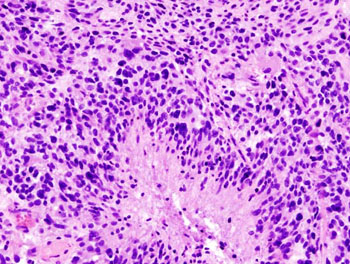Blocking Pair of Metalloproteases Halts Brain Tumor Growth
By LabMedica International staff writers
Posted on 05 Oct 2016
A team of British cancer researchers has identified the metalloprotease enzymes ADAM10 and ADAM17 as potential therapeutic targets for the treatment of glioblastoma multiforme (GBM) brain tumors.Posted on 05 Oct 2016
GBM is the most common primary tumor of the central nervous system and is almost always fatal. The aggressive invasion of GBM cells into the surrounding normal brain makes complete surgical removal impossible, significantly increases resistance to the standard therapy regimen, and virtually assures tumor recurrence. Median survival for newly diagnosed GBM is 14.6 months and declines to eight months for patients with recurrent GBM.

Image: A histopathological image of cerebral glioblastoma with Hematoxylin and esoin stain (Photo courtesy of Wikimedia Commons).
Investigators at the University of Southampton (United Kingdom) chose to study ADAM10 and ADAM17 due to their high expression in glioblastoma and their ability to activate cytokines and growth factors. ADAM10 and ADAM17 are members of the ADAM family of cell surface proteins that have unique structure possessing both potential adhesion and protease domains. Sheddase, a generic name for the ADAM metallopeptidases, functions primarily to cleave membrane proteins at the cellular surface. Once cleaved, the sheddases release soluble ectodomains with an altered location and function.
In order to study the roles of the two enzymes in GBM, the investigators isolated multipotent sphere-forming cells from human high-grade glioma (glioma sphere-forming cells (GSCs). Working with these cells, which also express high levels of ADAM10 and ADAM17, allowed the investigators to investigate their adhesive and migratory properties in vitro.
Results published in the August 19, 2016, online edition of the journal Molecular Neurobiology revealed that inhibition of ADAM10 and ADAM17 selectively increased GSC, but not neural stem cell, migration and that the migrated GSCs exhibited a differentiated phenotype, which meant that the tumor stopped growing and spreading. The investigators also observed a correlation between nestin, a stem/progenitor marker, and fibronectin, an extracellular matrix protein, expression in high-grade glioma tissues. These results suggested that therapies against ADAM10 and ADAM17 might promote cancer stem cell migration away from the site of tumor formation resulting in a differentiated phenotype that would be more susceptible to treatment.
“When confirmed in animal models of glioblastoma, this finding will be of great importance for patients and clinicians,” said senior author Dr. Sandrine Willaime-Morawek, lecturer in stem cells and brain repair at the University of Southampton. “Glioblastoma is a devastating disease which is often untreatable. We have found that blocking ADAMs may lead to reduced tumor growth and less recurrence following conventional treatments, improving the chance of complete surgical removal and improving survival rates."
Related Links:
University of Southampton













